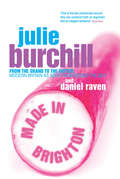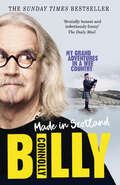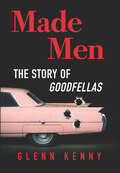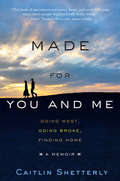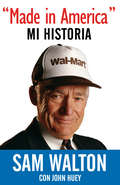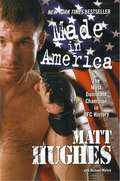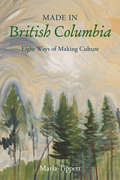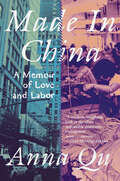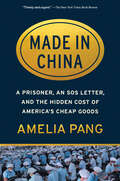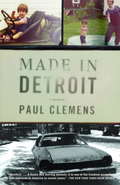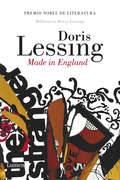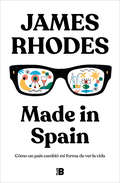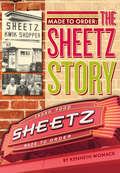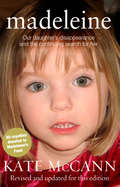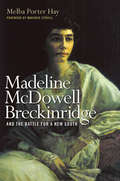- Table View
- List View
Maddie Ziegler (Influential People)
by Andrea PelleschiThe world saw Maddie Ziegler dance alongside pop star Sia. Now the young dancer is also a writer and actor. Learn more about Maddie's promising career!
Made In Brighton: From the grand to the gutter: Modern Britain as seen from beside the sea
by Julie Burchill Daniel RavenBritain is experiencing a sudden reckless rush of liberalisation, from 24 hour licensing to gay marriages. But how did we get from idolising Grace Kelly and Prince Rainier to Jordan and Peter Andre? Funny and bittersweet, Made In Brighton interweaves personal stories of life in Brighton with larger themes of sex, politics and class to take a cold, hard look at the changing face of Britain, and at the town which has always been at the vanguard of Britain's cultural evolution. From punk to dance, dope to coke, the Labour party to hen parties, straight to gay to bi, this book holds a mirror up to the dazed face of Britain and gives it a good hard slap.
Made In Scotland: My Grand Adventures in a Wee Country
by Billy ConnollyTHE SUNDAY TIMES BESTSELLER'Where do you come from? It's one of the most basic human questions of all. But there is another question, which might sound a wee bit similar but is actually very different: What do you come from? And, let me tell you, that question can take you all sorts of strange places...'In Made in Scotland, legendary comic and national treasure Billy Connolly returns to his roots, reflecting on his life, his homeland and what it means – then and now – to be Scottish. Full of Billy's distinctive humour, Made in Scotland is a hilarious and heartfelt love letter to the place and the people that made him.
Made Men: The Story of Goodfellas
by Glenn KennyA revealing look at the making of Martin Scorsese’s iconic mob movie and its enduring legacy, featuring interviews with its legendary cast.When Goodfellas first hit the theatres in 1990, a classic was born. Few could anticipate the unparalleled influence it would have on pop culture, one that would inspire future filmmakers and redefine the gangster picture as we know it today. From the rush of grotesque violence in the opening scene to the iconic hilarity of Joe Pesci’s endlessly quoted “Funny how?” shtick, it’s little wonder the film is widely regarded as a mainstay in contemporary cinema.In the first ever behind-the-scenes story of Goodfellas, film critic Glenn Kenny chronicles the making and afterlife of the film that introduced the real modern gangster. Featuring interviews with the film’s major players, including Martin Scorsese and Robert De Niro, Made Men shines a light on the lives and stories wrapped up in the Goodfellas universe, and why its enduring legacy has such a hold on American culture.A Library Journal Best Book of the YearA Sight and Sound Best Film Book of 2020
Made With Love: The Meals On Wheels Family Cookbook
by Enid BordenCelebrating the importance of family, Made With Love: The Meals On Wheels Family Cookbook includes recipes from the tables of well-known actors, chefs, writers, and other celebrities along with personal stories about their favorite family meals. Learn to cook: Patti LaBelle's Baja Fish Tacos Cokie Roberts' Artichoke Gratin Al Roker's New Orleans–Style Barbecued Shrimp Judi Dench's Bread and Butter Pudding Other contributors include Helen Mirren, Martha Stewart, former First Lady Barbara Bush, Mario Batali, Paula Deen, Joan Lunden, Kurt Warner, Dr. Maya Angelou, Joan Rivers, and many more. Providing more than a million meals a day for seniors across America, Meals On Wheels Association of America is the oldest and largest national organization of its kind. Each sale of Made With Love: The Meals On Wheels Family Cookbook helps to end senior hunger in America.
Made for This Moment: Standing Firm with Strength, Grace, and Courage
by Madison PrewettHow do you stand firm in your convictions in a world that's trying to pull you down? Madison Prewett helps you keep your standards high and your roots deep in this strikingly personal look at why you were made for this moment.When Madison Prewett competed on season 24 of The Bachelor, she was able to maintain her convictions not just because she was strong in the moment of pressure but because she was strong in the moments of preparation. In Made for This Moment, Madison examines how the biblical story of Esther will prepare you to:Discover how to predecide who you want to be before you step into your Big MomentsClaim your confidence so you can get out of the comparison gameLearn strategies for dealing with your past so it won't hinder your presentBreak free from the labels others put on youLearn how to respond to offense with grit and graceDiscover how to be yourself whether anyone is looking or notMade for This Moment will appeal to fans of Sadie Robertson, Jordan Lee Dooley, and Annie F. Downs, as well as to Madison's faithful following from her remarkable Bachelor season. Readers who are eager to make wise choices in dating, career, and family will love Madison's authentic voice and real-life challenges, making this a great gift for graduations, birthdays, or life transitions.Made for This Moment will help you navigate the complex realities of living in an age of social media and confusing standards. God's timing is not a mistake--you were made for such a time as this.
Made for You and Me: Going West, Going Broke, Finding Home
by Caitlin ShetterlyNewlywed Caitlin Shetterly and her husband, Dan Davis, two hardworking freelancers, began their lives together in 2008 by pursuing a lifelong, shared dream of leaving Maine and going West. At first, California was the land of plenty. Quickly, though, the recession landed, and a surprise pregnancy that was also surprisingly rough made Caitlin too sick to work. By December, every job Dan had lined up had been canceled, and though he pounded the pavement, from shop to shop and from bar to bar, he could not find any work at all. By March 2009, every cent of the couple's savings had been spent.So, a year after they'd set out with big plans, Caitlin and Dan packed up again, this time with a baby on board, to make their way home to move in with Caitlin's mother. As they drove, Caitlin blogged about their situation and created audio diaries for NPR's Weekend Edition--and received an astounding response. From all across the country, listeners offered help, opening their hearts and their homes. And when the young family arrived back in rural Maine and squeezed into Caitlin's mother's small saltbox house, Caitlin learned that the bonds of family run deeper than any tug to roam, and that, with love, she and Dan could hold their dreams in sight, wherever they were. Made for You and Me captures the irrepressible spirit and quiet perseverance of one small family--and offers to share that strength with any reader willing to make the journey.lin's mother's small saltbox house, Caitlin learned that the bonds of family run deeper than any tug to roam, and that, with love, she and Dan could hold their dreams in sight, wherever they were. Made for You and Me captures the irrepressible spirit and quiet perseverance of one small family--and offers to share that strength with any reader willing to make the journey. "There's a story of this country that doesn't get told a lot. Or told well. Of what it's like to not make it. Of having to say to yourself, and to your spouse and your child 'Listen, this isn't it. We need to try something else. We need to start over...from the very beginning.' Caitlin Shetterly's Made for You and Me is that story. Resonant and richly detailed, it takes you deep into the personal heart of the beginning of the financial crisis and the recession that followed. Then, somehow, via Venice, California, backwoods Maine and 3000 miles in between brings you out the other end."--Kai Ryssdal, host of NPR's Marketplace
Made from Scratch: Discovering the Pleasures of a Handmade Life
by Jenna WoginrichIn a hectic world of mass-produced food, clothing, and entertainment, it’s easy to miss out on the simple pleasures of doing things for yourself. Young web designer Jenna Woginrich chronicles her adventures as she learns to embrace the idea of self-sufficiency in all aspects of her life, including sewing her own clothes, growing her own food, and creating her own fun outside of the mainstream. Woginrich’s hilarious, heartbreaking, and soul-satisfying journey will bring joy and inspiration to those who dream about a more independent lifestyle.
Made in America: Mi Historia
by Sam Walton"Es una historia sobre el espíritu empresarial, el riesgo, y el trabajo duro, y sobre saber a dónde quieres ir y estar dispuesto a hacer lo que sea necesario para llegar allí. Es una historia sobre creer en tu idea, incluso cuando tal vez otras personas no creen en ella, y sobre apoyarte en tus mejores fortalezas". - Sam Walton Conozca a un genuino héroe popular americano proveniente del mero centro del corazón de los Estados Unidos: Sam Walton, un hombre que convirtió una única tienda de pueblo en Walmart, el negocio minorista más grande del mundo. Rey mercantil indiscutible de finales del siglo XX, Walton nunca perdió el toque de hombre común. Genuinamente modesto, pero siempre seguro de sus ambiciones y sus logros, Walton comparte su extraordinaria biografía con un estilo sincero y directo, y en sus propias palabras inimitables recuenta la historia de la inspiración, el corazón y el optimismo que lo impulsaron a alcanzar el sueño americano.
Made in America: Mi Historia (Biografias Ser.)
by Sam Walton"Es una historia sobre el espíritu empresarial, el riesgo, y el trabajo duro, y sobre saber a dónde quieres ir y estar dispuesto a hacer lo que sea necesario para llegar allí. Es una historia sobre creer en tu idea, incluso cuando tal vez otras personas no creen en ella, y sobre apoyarte en tus mejores fortalezas". - Sam WaltonConozca a un genuino héroe popular americano proveniente del mero centro del corazón de los Estados Unidos: Sam Walton, un hombre que convirtió una única tienda de pueblo en Walmart, el negocio minorista más grande del mundo. Rey mercantil indiscutible de finales del siglo XX, Walton nunca perdió el toque de hombre común. Genuinamente modesto, pero siempre seguro de sus ambiciones y sus logros, Walton comparte su extraordinaria biografía con un estilo sincero y directo, y en sus propias palabras inimitables recuenta la historia de la inspiración, el corazón y el optimismo que lo impulsaron a alcanzar el sueño americano.
Made in America: The Most Dominant Champion in UFC History (Ultimate Fighting Championship Ser.)
by Matt HughesIf you know anything at all about mixed martial arts and the UFC, then you know the name Matt Hughes. With devastating slams and ground-and-pound -- and nine championship belts to his credit -- Matt is the most dominant fighter in UFC history. Matt was raised with his twin brother on a family farm in small-town Hillsboro, Illinois. Behind the postcard-perfect fields of corn, beans, and wheat stood a home consumed by bankruptcy, tension, and interpersonal struggles, but Matt reacted to hard times by playing hard and working even harder. In high school and college Matt was an unstoppable wrestler, and he ended up a two-time Division I All-American. Whereas every year's top eight graduating college football players become instant millionaires, Matt got to stay on as assistant wrestling coach, doing electrical work on the side for fourteen dollars an hour. All of that changed the day he met legendary MMA manager Monte Cox, as well as Pat Miletich, a trainer who also happened to be the welterweight champion of the world. Rising through the ranks of the independent fighting circuit and the UFC, Matt saw things that fans could only catch glimpses of -- until now. For the first time, a major UFC superstar has decided to answer all the questions the fans have about him, the organization, and the sport. You'll learn which fighter almost sent Matt packing from mixed martial arts; why he refused to speak to his role model, Randy Couture; and what his relationship with UFC president Dana White is like. He reveals in which match he found himself praying to God for help, why he originally refused a shot at the world title, and what it's like training at the Miletich Fighting Camp. Matt describes working on TV's The Ultimate Fighter, what really happened to Tito Ortiz during the legendary brawl on the streets of London, just how personal his rivalry with Frank Trigg became, and what it was like to go up against the mythical Royce Gracie -- and destroy him. Matt discloses his most private thoughts and feelings during both his epic victories and his crushing losses. But when the gloves come off, there's Matt Hughes the man. He talks with unflinching honesty about his early hell-raising and his near-death experience, the moment he let God into his heart, falling in love with his wife, the birth of his daughter, and all the important events of his life -- and he shares personal photographs never before seen by the public. A Christian, a family man, and a fighter, Matt Hughes could only have been made in America.
Made in British Columbia
by Maria TippettIs there such a thing as British Columbia culture, and if so, is there anything special about it? This is the broad question Dr. Maria Tippett answers in this work with an assured "yes!" To prove her point she looks at the careers of eight ground-breaking cultural producers in the fields of painting, aboriginal art, architecture, writing, theatre and music. The eight creative figures profiled in Made in British Columbia are not just distinguished artists who made an enduring mark on Canadian culture during the twentieth century. They are unique artists whose work is intimately interwoven with British Columbia's identity. Emily Carr portrayed BC's coastal landscape in a manner as unique as her lifestyle. Bill Reid's carvings, jewellery and sculpture stand as a contemporary interpretation of his reclaimed Haida heritage. The name Francis Rattenbury is less known than The Empress Hotel in Victoria, one of many prominent BC buildings he designed, while Arthur Erickson's modern architectural contributions are recognized worldwide. Martin Allerdale Grainger's experience in the BC woods in the early days of hand-logging inspired him to write one of the undisputed classics of BC fiction, Woodsmen of the West. Jean Coulthard struggled for respect as a female composer during the 1920s and 1930s in British Columbia but eventually proved her extraordinary musical talents internationally. George Woodcock left Britain in 1949 to forge his career as an influential author, editor, mentor and tireless promoter of literary scholarship in the province, while playwright George Ryga, the son of Ukrainian immigrants, exposed the anguish and reality of life for Native women in our cities with his 1967 play, The Ecstasy of Rita Joe. Featuring images of the artists and their works, Made in British Columbia presents a history of the treasures found in our galleries, concert halls, theatres, museums, libraries and streetscapes, and explores the legacy of a cultural tradition as unique as the place that nurtured it.
Made in China: A Memoir of Love and Labor
by Anna QuA young girl forced to work in a Queens sweatshop calls child services on her mother in this powerful debut memoir about labor and self-worth that traces a Chinese immigrant's journey to an American future. <p><p> As a teen, Anna Qu is sent by her mother to work in her family's garment factory in Queens. At home, she is treated as a maid and suffers punishment for doing her homework at night. Her mother wants to teach her a lesson: she is Chinese, not American, and such is their tough path in their new country. But instead of acquiescing, Qu alerts the Office of Children and Family Services, an act with consequences that impact the rest of her life. Nearly twenty years later, estranged from her mother and working at a Manhattan start-up, Qu requests her OCFS report. When it arrives, key details are wrong. <p><p> Faced with this false narrative, and on the brink of losing her job as the once-shiny start-up collapses, Qu looks once more at her life's truths, from abandonment to an abusive family to seeking dignity and meaning in work. Traveling from Wenzhou to Xi'an to New York, Made in China is a fierce memoir unafraid to ask thorny questions about trauma and survival in immigrant families, the meaning of work, and the costs of immigration.
Made in China: A Prisoner, an SOS Letter, and the Hidden Cost of America's Cheap Goods
by Amelia PangA Most-Anticipated Book of the Year: Newsweek * Refinery29 &“Timely and urgent . . . Pang is a dogged investigator.&” —The New York Times Book Review&“Moving and powerful.&” —Chris Hedges, Pulitzer Prize–winning journalist and author Discover the truth behind the discounts In 2012, an Oregon mother named Julie Keith opened up a package of Halloween decorations. The cheap foam headstones had been five dollars at Kmart, too good a deal to pass up. But when she opened the box, something shocking fell out: an SOS letter, handwritten in broken English. &“Sir: If you occassionally buy this product, please kindly resend this letter to the World Human Right Organization. Thousands people here who are under the persicuton of the Chinese Communist Party Government will thank and remember you forever.&” The note&’s author, Sun Yi, was a mild-mannered Chinese engineer turned political prisoner, forced into grueling labor for campaigning for the freedom to join a forbidden meditation movement. He was imprisoned alongside petty criminals, civil rights activists, and tens of thousands of others the Chinese government had decided to &“reeducate,&” carving foam gravestones and stitching clothing for more than fifteen hours a day. In Made in China, investigative journalist Amelia Pang pulls back the curtain on Sun&’s story and the stories of others like him, including the persecuted Uyghur minority group whose abuse and exploitation is rapidly gathering steam. What she reveals is a closely guarded network of laogai—forced labor camps—that power the rapid pace of American consumerism. Through extensive interviews and firsthand reportage, Pang shows us the true cost of America&’s cheap goods and shares what is ultimately a call to action—urging us to ask more questions and demand more answers from the companies we patronize.
Made in Detroit: A South of 8 Mile Memoir
by Paul ClemensANew York TimesNotable Book A powerfully candid memoir about growing up white in Detroit and the conflicted point of view it produced. Raised in Detroit during the '70s, '80s, and '90s, Paul Clemens saw his family growing steadily isolated from its surroundings: white in a predominately black city, Catholic in an area where churches were closing at a rapid rate, and blue-collar in a steadily declining Rust Belt. As the city continued to collapse--from depopulation, indifference, and the racial antagonism between blacks and whites--Clemens turned to writing and literature as his lifeline, his way of dealing with his contempt for suburban escapees and his frustration with the city proper. Sparing no one--particularly not himself--this is an astonishing examination of race and class relations from a fresh perspective, one forged in a city both desperate and hopeful.
Made in England
by Doris Lessing«No podría recordar ningún momento de mi vida en el que no deseara yo ir a Inglaterra», comenta Doris Lessing en este delicioso libro de memorias que es el compendio ideal a sus dos volúmenes de autobiografía. Ese momento mágico llegó para la autora en 1949, cuando dejó Zimbabue con su hijo para viajar por primera vez a la isla y establecerse en Londres. En aquel entonces la gran ciudad empezaba a recuperarse después de los desastres de la Segunda Guerra Mundial, y no fue fácil para una joven madre sin trabajo fijo y con muchas ganas de escribir encontrar un lugar donde asentarse y descubrir al mismo tiempo la esencia de lo inglés.«Cada una de sus páginas lleva el sello de la verdad y es incontestablemente legible, como ocurre con la ficción de primera.»Time
Made in England
by Doris LessingLos primeros tiempos de Doris Lessing en Inglaterra. «No podría recordar ningún momento de mi vida en el que no deseara yo ir a Inglaterra», comenta Doris Lessing en este delicioso libro de memorias que es el compendio ideal a sus dos volúmenes de autobiografía. Ese momento mágico llegó para la autora en 1949, cuando dejó Zimbabue con su hijo para viajar por primera vez a la isla y establecerse en Londres. En aquel entonces la gran ciudad empezaba a recuperarse después de los desastres de la Segunda Guerra Mundial, y no fue fácil para una joven madre sin trabajo fijo y con muchas ganas de escribir encontrar un lugar donde asentarse y descubrir al mismo tiempo la esencia de lo inglés. Reseña:«Cada una de sus páginas lleva el sello de la verdad y es incontestablemente legible, como ocurre con la ficción de primera.»Time
Made in Reality
by Stephanie PrattThe Sunday Times bestseller.Stephanie Pratt is the consummate reality star.Since 2007, her life has been lived almost as much on the small screen as off it, and constantly analysed in gossip columns. In Made in Reality, Stephanie gives an exclusive insight into the trials and tribulations of life on reality TV, taking us behind the scenes of The Hills, Made in Chelsea and even the Big Brother House. In her tell- all autobiography, nothing is off-limits, from the drama of her relationship with Spencer Matthews to her issues with her brother Spencer Pratt. For the first time, she shares her struggles with drug addiction, eating disorders, and the pressures of fame in the internet age.Inspiring, fascinating, and insightful throughout, this is an honest account of the truth behind reality.
Made in Reality
by Stephanie PrattThe Sunday Times bestseller.Stephanie Pratt is the consummate reality star.Since 2007, her life has been lived almost as much on the small screen as off it, and constantly analysed in gossip columns. In Made in Reality, Stephanie gives an exclusive insight into the trials and tribulations of life on reality TV, taking us behind the scenes of The Hills, Made in Chelsea and even the Big Brother House. In her tell- all autobiography, nothing is off-limits, from the drama of her relationship with Spencer Matthews to her issues with her brother Spencer Pratt. For the first time, she shares her struggles with drug addiction, eating disorders, and the pressures of fame in the internet age.Inspiring, fascinating, and insightful throughout, this is an honest account of the truth behind reality.
Made in Reality
by Stephanie PrattStephanie Pratt is the consummate reality star.Since 2007, her life has been lived almost as much on the small screen as off it, and constantly analysed in gossip columns. In Made in Reality, Stephanie gives an exclusive insight into the trials and tribulations of life on reality TV, taking us behind the scenes of The Hills, Made in Chelsea and even the Big Brother House. Nothing is off-limits, from the drama of her relationship with Spencer Matthews, to her issues with her brother Spencer Pratt. But there is more to Stephanie than the glamour of Beverly Hills and the Kings Road. For the first time, she shares her struggles with drug addiction, eating disorders, and the pressures of fame in the internet age.Inspiring, fascinating, and insightful throughout, this is an honest account of the truth behind reality.(P)2015 Headline Digital
Made in Spain: Cómo un país cambió mi forma de ver la vida
by James RhodesMade in Spain es un testimonio sincero, unas veces agridulce y otras lleno de humor, que nos recuerda el poder de las segundas oportunidades. Alguna vez has querido volver a empezar? Un nuevo comienzo, un nuevo hogar, una nueva familia. Una nueva vida… El pianista James Rhodes recrea en este libro el largo camino que emprendió cuando decidió dejar atrás el drama sufrido en el Reino Unido para encontrar, por fin, su verdadero lugar en el mundo. Desde su llegada a España hasta su historia de amor (tanto por un país como por una mujer), pasando por su fascinación gastronómica(«nada que ver con la paella de Jamie Oliver»), las batallas políticas, la pena, el choque cultural y su descubrimiento de la lengua española, Rhodes nos lleva, página tras página, a través de un relato que es un auténtico canto a lo mejor de la vida. «Necesitaba escribir este libro. Un viaje de la angustia a la felicidad. Una carta de amor al país que me ha regalado un hogar.» Reseñas:«James Rhodes tiene el don de saber crear libros únicos e inclasificables, llenos de humor, verdad, valentía y emoción. Made in Spain sigue esta regla y añade, para los españoles, un espejo en el que mirarnos y quizá hasta curarnos de algunos complejos».Rosa Montero «James Rhodes es un caso singular. Merece la pena escuchar su música y leer sus libros.»Eduardo Mendoza «Made in Spain debería ser de lectura obligatoria para todos los que a veces nos olvidamos de que, a pesar de todo, el nuestro es un gran país.»Juan Gómez-Jurado
Made to Order: The Sheetz Story
by Kenneth WomackMade To Order: The Sheetz Story traces the fascinating history of Sheetz, Inc., a regional convenience retailer that battled the odds and cemented its name among the acclaimed ranks of America's most successful private companies. From its humble dairy store origins in Pennsylvania, Sheetz became a convenience-store giant, amassing hundreds of locations across six states, and along the way, combined numerous creative marketing campaigns with retail innovations to shape the Sheetz recipe for success. Made To Order: The Sheetz Story narrates how the company remade itself in the face of dramatically shifting demographics, bravely stood up for its customer base when confronted with a serious crisis, and emerged as a revered and much-beloved retail phenomenon.
Madeleine: Our daughter's disappearance and the continuing search for her
by Kate McCannKate McCann's personal account of the disappearance and continuing search for her daughter, revised and updated.'The decision to publish this book has been very difficult, and taken with heavy hearts ... My reason for writing it is simple: to give an account of the truth ... Writing this memoir has entailed recording some very personal, intimate and emotional aspects of our lives. Sharing these with strangers does not come easily to me, but if I hadn't done so I would not have felt the book gave as full a picture as it is possible for me to give. As with every action we have taken over the last five years, it ultimately boils down to whether what we are doing could help us to find Madeleine. When the answer to that question is yes, or even possibly, our family can cope with anything ... Nothing is more important to us than finding our little girl.' -- Kate McCann'A must-read' Sunday Express'Kate's book blazes with the sheer visceral force of her love for her daughter' Daily Mail'Deeply moving' Guardian
Madeline Kahn: Being the Music, A Life (Hollywood Legends Series)
by William V. MadisonBest known for her Oscar-nominated roles in the smash hits Paper Moon and Blazing Saddles, Madeline Kahn (1942–1999) was one of the most popular comedians of her time—and one of the least understood. In private, she was as reserved and refined as her characters were bold and bawdy. Almost a Method actor in her approach, she took her work seriously. When crew members and audiences laughed, she asked why—as if they were laughing at her—and all her life she remained unsure of her gifts. William V. Madison examines Kahn's film career, including not only her triumphs with Mel Brooks and Peter Bogdanovich, but also her overlooked performances in The Adventure of Sherlock Holmes' Smarter Brother and Judy Berlin, her final film. Her work in television—notably her sitcoms—also comes into focus. New York theater showered her with accolades, but also with remarkably bad luck, culminating in a disastrous outing in On the Twentieth Century that wrecked her reputation on Broadway. Only with her Tony-winning performance in The Sisters Rosensweig, fifteen years later, did Kahn regain her standing. Drawing on new interviews with family, friends, and such colleagues as Lily Tomlin, Carol Burnett, Gene Wilder, Harold Prince, and Eileen Brennan, as well as archival press and private writings, Madison uncovers Kahn's lonely childhood and her struggles as a single woman working to provide for her erratic mother. Above all, Madison reveals the paramount importance of music in Kahn's life. A talented singer, she entertained offers for operatic engagements long after she was an established Hollywood star, and she treated each script as a score. As Kahn told one friend, her ambition was “to be the music.”
Madeline McDowell Breckinridge and the Battle for a New South (Topics in Kentucky History)
by Melba Porter HayA biography of the Kentucky women’s rights activist and progressive reformer, featuring personal interviews and recently discovered correspondence.Preeminent Kentucky reformer and women’s rights advocate Madeline McDowell Breckinridge (1872-1920) was at the forefront of social change during the late nineteenth and early twentieth centuries. A descendant of Henry Clay and the daughter of two of Kentucky’s most prominent families, Breckinridge had a remarkably varied activist career that included roles in the promotion of public health, education, women’s rights, and charity. Founder of the Lexington Civic League and Associated Charities, Breckinridge successfully lobbied to create parks and playgrounds and to establish a juvenile court system in Kentucky. She also became president of the Kentucky Equal Rights Association, served as vice president of the National American Woman Suffrage Association, and even campaigned across the country for the League of Nations.In the first biography of Breckinridge since 1921, Melba Porter Hay draws on newly discovered correspondence and rich personal interviews with her female associates to illuminate the fascinating life of this important Kentucky activist. Deftly balancing Breckinridge’s public reform efforts with her private concerns, Hay tells the story of Madeline’s marriage to Desha Breckinridge, editor of the Lexington Herald, and how she used the match to her advantage by promoting social causes in the newspaper. Hay also chronicles Breckinridge’s ordeals with tuberculosis and amputation, and emotionally trying episodes of family betrayal and sex scandals. Hay describes how Breckinridge’s physical struggles and personal losses transformed her from a privileged socialite into a selfless advocate for the disadvantaged. Later as vice president of the National American Women Suffrage Association, Breckinridge lobbied for Kentucky’s ratification of the Nineteenth Amendment, which gave women the right to vote in 1920. While devoting much of her life to the woman suffrage movement on the local and national levels, she also supported the antituberculosis movement, social programs for the poor, compulsory school attendance, and laws regulating child labor.In bringing to life this extraordinary reformer, Hay shows how Breckinridge championed Kentucky’s social development during the Progressive Era.Praise for Madeline McDowell Breckinridge and the Battle for a New South“An important contribution to American history, one that is of special significance to Kentucky history, the Progressive Era, and the women's rights movement.” —Paul Fuller, author of Laura Clay and the Women’s Rights Movement“Hay brings to life a multi-dimensional woman, emblematic of her times, with whom readers can identify and sympathize.” —Melanie Beals Goan, author of Mary Breckinridge: The Frontier Nursing Service and Rural Health in Appalachia

